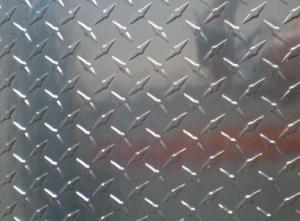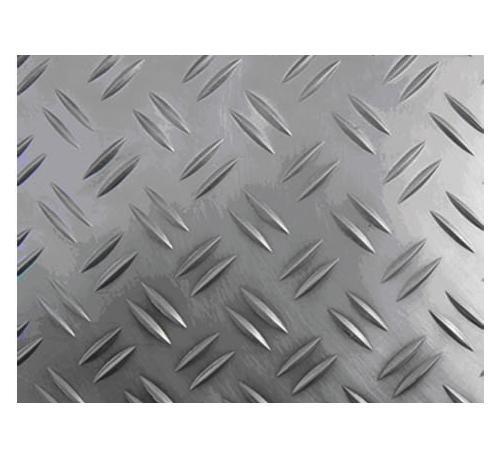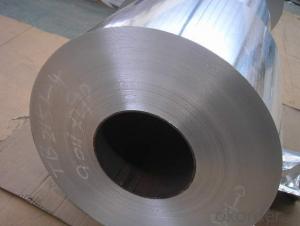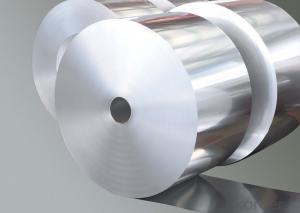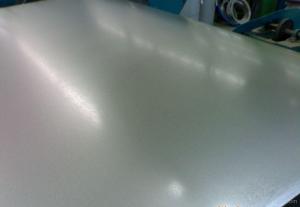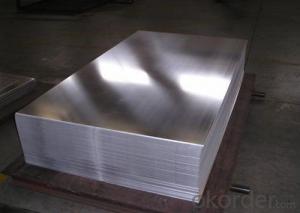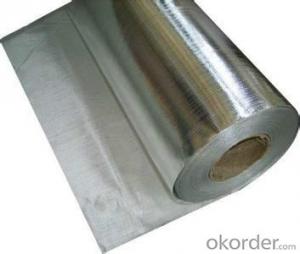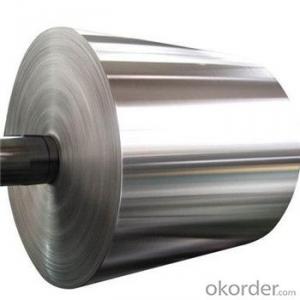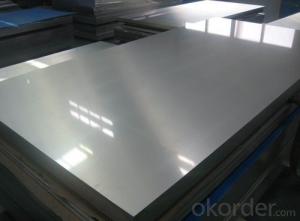Self-Adhesive Aluminum Foil Sheets with Smooth Surface
- Loading Port:
- Shanghai
- Payment Terms:
- TT or LC
- Min Order Qty:
- 5 m.t.
- Supply Capability:
- 9000 m.t./month
OKorder Service Pledge
OKorder Financial Service
You Might Also Like
Aluminum Checkered Plate for Five-Bar :
two bar five bar Aluminum Checkered Sheet Plate
1.Alloy: 1100 1200 1050 2024 2014 2017 3003 5052 6061 6063 etc.
2. Temper: O, F, H111, H112, H12 ,H14, H16, H18, H19, H22, H24, H26, H32, H34, H36, H38, T3, T4 , T6, T7, T351 , T451, T651, T851.
3. Dimensions can be produced according to clients specifications.
4.Good plasticity, conductivity.
5. Generally used in industry and architecture industries.
Packing,
Covering with standard and package or according to your demand.

Machinability :
This alloy has relatively fair machinability. It is easier to machine in the hard temper than as annealed and the quality of finish is better if machined in the hard condition. Oil lubricants should be used for machining, except that very light cuts may .

Forming :
AL 5052 is readily formed at room temperature. Successive cold working decreases the formability.
Corrosion Resistance :
Corrosion resistance to salt water and general atmospheric conditions is good.
Heat Treatment:
AL 5052 cannot be hardened by means of heat treatment. It does harden due to cold working.

- Q: Are the aluminum sheets suitable for manufacturing lightweight structures?
- Yes, aluminum sheets are highly suitable for manufacturing lightweight structures. Aluminum is known for its low density, making it one of the lightest metals available. This characteristic makes aluminum sheets an excellent choice for various applications where weight reduction is a priority, such as aerospace, automotive, and construction industries. Additionally, aluminum has a high strength-to-weight ratio, meaning it can withstand significant loads while still remaining lightweight. Furthermore, aluminum sheets offer excellent corrosion resistance, making them suitable for outdoor and marine applications. Overall, the combination of its lightness, strength, and durability makes aluminum sheets a preferred choice for manufacturing lightweight structures.
- Q: Can aluminum sheets be used in marine environments?
- Yes, aluminum sheets can be used in marine environments. Aluminum is a commonly used material in marine applications due to its excellent corrosion resistance properties and lightweight nature. It can withstand the harsh conditions of saltwater, making it suitable for boat building, marine structures, and other marine-related uses.
- Q: What is the electrical conductivity of aluminum sheets?
- The electrical conductivity of aluminum sheets is quite high, making aluminum one of the best conductors of electricity among common metals. It has a conductivity rating of approximately 37.7 x 10^6 siemens per meter (S/m). This high electrical conductivity makes aluminum a preferred choice for various electrical applications, such as wiring, power transmission lines, and electrical connectors.
- Q: Are aluminum sheets suitable for insulation purposes?
- Yes, aluminum sheets are suitable for insulation purposes. Aluminum is a highly reflective material that can effectively block the transfer of heat, making it an excellent choice for insulation. It has a low emissivity value, meaning that it reflects heat radiation rather than absorbing it. This property helps to maintain a consistent temperature within a space, reducing the need for heating or cooling. Additionally, aluminum sheets are lightweight, easy to install, and resistant to moisture, making them a practical option for insulation in various applications such as attics, walls, floors, and HVAC systems.
- Q: What are the different types of surface treatments available for powder-coated aluminum sheets?
- Some different types of surface treatments available for powder-coated aluminum sheets include anodizing, chemical etching, mechanical polishing, and electroplating. Each treatment offers unique benefits and can enhance the appearance, durability, and corrosion resistance of the aluminum sheets.
- Q: Heating aluminum plate, heating scheme, urgent ~!
- For aluminum heating silicon heating plate is a good choice. The four corners can be fixed by screws, Beijiao can. Installation is very convenient. I was in the goodway procurement. They are guaranteed for one year.
- Q: According to the reactivity of metals, aluminum chloride (AlCl3) will not react with copper (Cu). But I am almost sure that the copper nail I put in the aluminum chloride solution became shiny and lost its copper lust. Why did this reaction happen?
- it particularly is authentic that many deodorants, quite those categorized anti-perspirants, incorporate aluminum chloride as an lively ingredient. Aluminum chloride does decrease sweat production via the sweat glands that are placed interior the floor and are quite ample under the hands. For some people who're heavy sweaters this drying consequence is amazingly significant. despite the fact that those deodorants decrease sweat production they do no longer block the sweat glands. we are no longer attentive to any at as quickly as risky outcomes on maximum persons from making use of a deodorant containing aluminum chloride. In our very close society at present, physique hygiene and prevention of physique smell are significant. in case you do no longer use a deodorant you are able to discover your persons the two complaining or keeping off you. while you're worried with reference to the drying consequence seem for a deodorant that would not incorporate aluminum chloride.
- Q: This question asks for methods to preserve an aluminum window and prevent rust or corrosion.
- <p>To maintain an aluminum window and prevent rusting or corrosion, follow these steps: Regularly clean the window with a mild detergent and water to remove dirt and grime. Avoid using abrasive cleaners or tools that could scratch the surface. Apply a protective coating or sealant designed for aluminum to shield it from moisture and environmental factors. Ensure proper drainage around the window to prevent water accumulation. Regularly inspect the window for signs of damage or corrosion and address any issues promptly. By following these maintenance practices, you can prolong the life of your aluminum window and keep it in good condition.</p>
- Q: Are aluminum sheets suitable for marine vessel construction?
- Yes, aluminum sheets are suitable for marine vessel construction. Aluminum is a lightweight yet strong material that offers excellent corrosion resistance in marine environments. It is commonly used in the construction of various marine vessels, including boats, ships, and yachts. One of the main advantages of using aluminum sheets in marine vessel construction is their high strength-to-weight ratio. This allows for the construction of lighter vessels, which can result in improved fuel efficiency, increased speed, and better handling. Additionally, the lightweight nature of aluminum makes it easier to transport and maneuver during the construction process. Another key benefit of aluminum sheets for marine vessel construction is their exceptional resistance to corrosion. Aluminum naturally forms a protective oxide layer on its surface, which prevents further oxidation and corrosion. This makes aluminum an ideal choice for marine environments, where vessels are constantly exposed to saltwater, humidity, and other corrosive elements. Furthermore, aluminum sheets can be easily fabricated and welded, providing flexibility in the design and construction of marine vessels. They can be shaped into various forms, allowing for the creation of complex hull structures and interior components. Aluminum also offers good thermal conductivity, which can help regulate temperature in the interior spaces of marine vessels. While aluminum sheets have many advantages for marine vessel construction, it is important to consider certain factors. Aluminum is susceptible to galvanic corrosion when it comes into contact with certain metals, such as steel or bronze. Therefore, proper insulation and anti-corrosion measures should be taken to prevent galvanic corrosion in aluminum-based vessels. In conclusion, aluminum sheets are highly suitable for marine vessel construction. Their lightweight, high strength-to-weight ratio, corrosion resistance, and ease of fabrication make them an ideal choice for building durable and efficient marine vessels. However, proper precautions should be taken to prevent galvanic corrosion when aluminum is used alongside other metals.
- Q: What are the different methods for cutting aluminum sheets?
- Aluminum sheets can be cut using various methods that are commonly employed. 1. Shearing: To make a straight cut through the aluminum sheet, a sharp blade is used in this method. Shearing is typically used for thinner sheets and results in clean and straight cuts. 2. Sawing: Another method for cutting aluminum sheets is sawing. It involves the use of a saw blade with small teeth to cut through the material. Sawing can be done manually or with the assistance of power tools like band saws or circular saws. 3. CNC Machining: For highly precise cutting of aluminum sheets, Computer Numerical Control (CNC) machining is employed. This method utilizes a computer-controlled machine that follows programmed instructions to achieve the desired shape. CNC machines are capable of creating complex cuts and shapes with great accuracy. 4. Laser Cutting: A non-contact method, laser cutting, employs a high-powered laser to cut through aluminum sheets. The laser beam melts or vaporizes the aluminum, resulting in a clean and precise cut. Laser cutting is commonly used for intricate designs and offers a high level of precision. 5. Waterjet Cutting: Waterjet cutting involves the use of a high-pressure jet of water mixed with an abrasive substance to cut through aluminum sheets. This method is versatile and can be used for various materials and thicknesses. It produces clean cuts without generating heat, making it suitable for heat-sensitive materials as well. 6. Plasma Cutting: Plasma cutting utilizes a high-temperature plasma arc to cut through aluminum sheets. The plasma arc melts the metal and blows away the molten material, creating the desired cut. This method is commonly used for thicker aluminum sheets and can be done manually or with the assistance of CNC machines. These different cutting methods offer varied precision levels, speeds, and suitability for different sheet thicknesses and designs. The choice of cutting method depends on factors such as the desired cut quality, aluminum sheet thickness, and specific project requirements.
Send your message to us
Self-Adhesive Aluminum Foil Sheets with Smooth Surface
- Loading Port:
- Shanghai
- Payment Terms:
- TT or LC
- Min Order Qty:
- 5 m.t.
- Supply Capability:
- 9000 m.t./month
OKorder Service Pledge
OKorder Financial Service
Similar products
Hot products
Hot Searches
Related keywords
